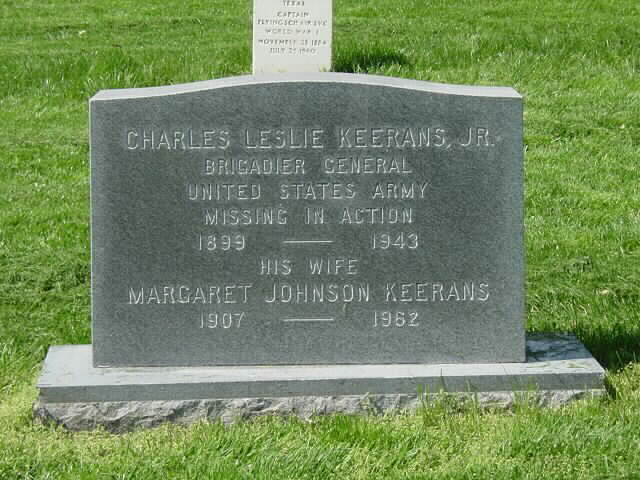Born at Charlotte, North Carolina.
Graduated From The United States Military Academy at West Point, New York, With The Class of 1919
Missing in action near Sicily, Italy, 11 July 1943
Charles L. Keerans, Jr.
Brigadier General, U.S. Army
Service # O-012504
Headquarters, 82nd Airborne Division
Entered the Service from: North Carolina
Died: 11-Jul-43
Missing in Action or Buried at Sea
Tablets of the Missing at Sicily-Rome American Cemetery
Nettuno, Italy
Awards: Purple Heart
Charles Dobbins was killed on July 11, 1943. He was a co-pilot of a C-47 of the 316th Troop Carrier Group, carrying paratroopers of the 376th Parachute Field Artillery Battalion, 82nd Airborne Division. The operation was called Husky II.
D-Day for operation Husky was 10 July 1943 and it all took place in southern Sicily. During the night of 9-10 July 226 C-47s (military version of the DC-3) took off with paratroopers of the 505th Regimental Combat Team (505th Parachute Infantry Regiment, B Company 307th Airborne Engineer Battalion and the 456th Parachute Field Artillery Battalion), this Combat Team was reinforced by the 3rd Battalion 504th Parachute Infantry, more than 3,400 paratroopers in total. The paratroopers were dropped behind the beaches. Due to several reasons, the paratroopers landed over entire southern Sicily. I have no knowledge if Captain Dobbins participated in this mission, but I assume he did.
In the early hours of 10 July, the U.S. infantry stormed the beaches. In the southeastern part of the island British troops landed.
In the evening of 10 July they was supposed to drop reinforcements, but the mission was postponed by 24 hours. Then on the evening of 11 July the planes took off. This time there were 144 planes, including Captain Dobbins’ plane. The pliot was Major Dekker; besides the paratroopers of the 376th Parachute Field Artillery, there were two observers, non paratroopers. One of them was Brigadier General Charles L. Keerans Jr, Deputy Commanding Officer of the 82nd Airborne Division. The other observer was Tracy Jackson. He had his Captain bars, but was – unknown to him – promoted to Major. He was the Glider Officer for the 52nd Troop Carrier Wing.
When the 144 planes flew to Sicily, they had to fly over the invasion fleet off the coast of Sicily. They were under constant attack from the German Luftwaffe. The gunners were trigger happy and fired on the planes. Then the Troop Carriers came over. Some gunner opened up, and more and more gunners joined him. A total of twenty-three planes transportplanes were shot down. Young American lives were lost due to friendly fire from American warships, American merchant ships, and infantry units on the coast of Sicily.
Brigadier General Charles L. Keerans, Jr. was the assistant commander of the 82nd Airborne Division.
His death was one of the oddest to occur during the war.
In 1943 the 82nd had prepared to make a night combat jump into the area around the Gulf of Gela, on the western coast of Italy. The effort was plagued with problems, including several American transport planes being shot down by friendly fire.
Keerans’ plane was one of those hit by friendly fire, but the pilot was able to crash land the plane in the water, 400 yards off shore. Keerans survived the crash and the next morning chatted with a Sergeant from another unit and asked the Sergeant to accompany him inland. The Sergeant said that he wanted to return to his outfit and left. Keerans went inland by himself and was never seen again.
For several years the army assumed he had been killed during the ditching of the aircraft, but the sergeant’s story provided a different interpretation and the general was simply listed as killed in action, although his body was never found.
Charles L. Keerans, Jr.
Brigadier General, U.S. Army
Service # O-012504
Headquarters, 82nd Airborne Division
Entered the Service from: North Carolina
Died: 11-Jul-43
Missing in Action or Buried at Sea
Tablets of the Missing at Sicily-Rome American Cemetery
Nettuno, Italy
Awards: Purple Heart
KEERANS, MARGARET J WID/O CHARLES LESLIE JR
- DATE OF BIRTH: 06/06/1906
- DATE OF DEATH: 04/11/1962
- BURIED AT: SECTION 30 SITE 901-B
ARLINGTON NATIONAL CEMETERY - WIFE OF CL KEERANS, JR., B/GEN JUL 1943 82ND AIRBORNE DIV USA
Michael Robert Patterson was born in Arlington and is the son of a former officer of the US Army. So it was no wonder that sooner or later his interests drew him to American history and especially to American military history. Many of his articles can be found on renowned portals like the New York Times, Washingtonpost or Wikipedia.
Reviewed by: Michael Howard

